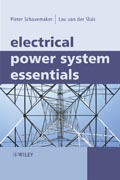
Electrical Power System Essentials provides an accessible, broad, and up-to-date overview of alternating current (AC) power systems, focusing on the systemas a whole rather than analyzing in detail the modeling of component parts (as is the case in classical power engineering textbooks). Throughout, the authors take care to always provide examples and case studies in order to back up theory or techniques presented. Information on mathematical modeling and equations are set out in appendices, rather than integrated in a potentially confusing way in the text, making the text accessible for undergraduate students and readers without a technical background directly related to power engineering. INDICE: 1 Introduction to Power System Analysis. 1.1 Introduction. 1.2 Scope of the material. 1.3 General characteristics of power systems. 1.4 Phasors.1.5 Equivalent line-to-neutral diagrams. 1.6 Power in single-phase circuits. 1.7 Power in three-phase circuits normalization. 1.8 Per unit normalization. 1.9 Power system structure. 2 The Generation of Electric Energy. 2.1 Introduction. 2.2 Thermal power plants. 2.3 Nuclear power plants. 2.4 Renewable energy. 2.5 The synchronous machine. 3 The Transmission of Electric Energy. 3.1 Introduction. 3.2 Transmission and distribution network. 3.3 Network structures. 3.4Substations. 3.5 Substation concepts. 3.6 Protection of transmission and distribution networks. 3.7 Transformers. 3.8 Power carriers. 4 The Utilization of Electric Energy. 4.1 Introduction. 4.2 Types of load. 4.3 Classification of grid users. 5 Power System Control. 5.1 Introduction. 5.2 Basics of power systemcontrol. 5.3 Active power and frequency control control. 5.4 Voltage control and reactive power. 5.5 Control of transported power. 5.6 Flexible AC Transmission Systems (FACTS). 6 Energy Management Systems. 6.1 Introduction. 6.2 Loadflow or power flow computation. 6.3 Optimal powerflow. 6.4 State estimator. 7 Electricity Markets. 7.1 Introduction. 7.2 Electricity market structure. 7.3 Market clearing. 7.4 Social welfare. 7.5 Market coupling. 8 Future Power Systems. 8.1 Introduction. 8.2 Renewable energy. 8.3 Decentralized or distributed generation. 8.4 Power-electronic interfaces. 8.5 Energy storage. 8.6 Blackouts and chaotic phenomena. A Maxwells laws. A.1 Introduction. A.2 Power series approach to time-varying fields. A.3 Quasi-static field of a parallel-plate capacitor. A.4 Quasi-static field of a single-turn inductor. A.5 Quasi-static field of a resistor. A.6 Circuit modeling. B Power transformer model. B.1 Introduction. B.2 The ideal transformer. B.3 Magnetically-coupled coils. B.4 The non-ideal transformer. B.5 Three-phase transformer. C Synchronous machine model. C.1 Introduction. C.2 The primitive synchronous machine. C.3 The single-phase synchronous machine. C.4 The three-phase synchronous machine. C.5 Synchronous generator in the power system. D Induction machine model. D.1 Introduction. D.2 Thebasic principle of the induction machine. D.3 The magnetic field in the air gap. D.4 A simple circuit model for the induction machine. D.5 Induction motor in the power system. E The representation of lines and cables. E.1 Introduction. E.2 The long transmission line. E.3 The medium-length transmission line. E.4 The short transmission line. E.5 Comparison of the three line models. E.6 The underground cable. List of Abbreviations. List of Symbols. Index.
- ISBN: 978-0-470-51027-8
- Editorial: John Wiley & Sons
- Encuadernacion: Cartoné
- Páginas: 352
- Fecha Publicación: 29/02/2008
- Nº Volúmenes: 1
- Idioma: Inglés
